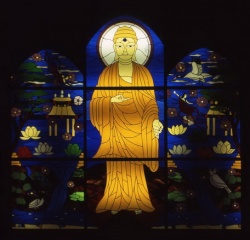Four sights
According to Buddhist the four sights were specific observations made by Prince Siddhārtha (who later became Gautama Buddha), which led to a realization. Before this, he had been confined to his palace by his father, who feared that he would become an ascetic if he came into contact with sufferings of life according to a prediction. However, on his first venture out of the palace with his charioteer Channa, he observed four sights; an old man, a sick man, a corpse and an ascetic. These observations affected him deeply and made him realize the sufferings of all beings, and compelled him to begin his spiritual journey which led into his enlightenment.
Background
After the birth of the Prince Siddhārtha, King Śuddhodana called upon eight Brahmins to predict his son's future. While seven of them declared that the prince would either be a Buddha or a great King, the Brahmin Kaundinya was confident that he would renounce the world and become a Buddha.
Śuddhodana, who was determined that his son should be a king, confined the prince within the palace and surrounded him with earthly pleasures and luxury, thereby concealing the realities of life that may encourage him to renounce these pleasures and become an ascetic. Observing the sights
After leading a sheltered existence surrounded by luxury and pleasure in his younger years, Prince Siddhārtha ventured out of his palace for the first time at the age of 29. He set off from the palace to the city in a chariot, accompanied by his charioteer Channa (Chandaka).
On this journey he first saw an old man, revealing to Siddhārtha the consequences of aging. When the prince asked about this person, Channa replied that aging was something that happened to all beings alike.
The second sight was of a sick person suffering from a disease. Once again, the prince was surprised at the sight, and Channa explained that all beings are subject to disease and pain. This further troubled the mind of the prince.
The third sight was of a Dead body. As before, Channa explained to the prince that death is an inevitable fate that befalls everyone. After seeing these three sights, Siddhārtha was troubled in his mind and sorrowful about the sufferings that have to be endured in life.
After seeing these three negative sights, Siddhārtha came upon the fourth sight; an ascetic who had devoted himself to finding the cause of human suffering. This sight gave him hope that he too might be released from the sufferings arising from being repeatedly reborn,[3] and he resolved to follow the ascetic's example. Different versions
Some accounts say that the four sights were observed by Siddhārtha in one day, during a single journey. Others describe that the four sightings were observed by him on four separate occasions. Some versions of the story also say that the prince's father had the route beautified and guarded to ensure that he does not see anything that might turn his thoughts towards suffering. However, devas (deities) conjured up these four sightings, knowing that the liberation of all beings from suffering was based on the prince observing the realities of life.[4] Aftermath
After observing these four sights, Siddhārtha returned to the palace, where a performance of dancing girls was arranged for him. Throughout the performance, the prince kept on thinking about the sights. In the early hours of morning, he finally looked about him and saw the dancers asleep and in disarray. The sight of this drastic change strengthened his resolve to leave in search of an end to the suffering of beings.
After this incident and realizing the true nature of life after observing the four sights,[3] Siddhārtha left the palace on his horse Kanthaka, accompanied only by Channa. He sent Channa back with his possessions and began an ascetic life, at the end of which he attained enlightenment as Gautama Buddha.
